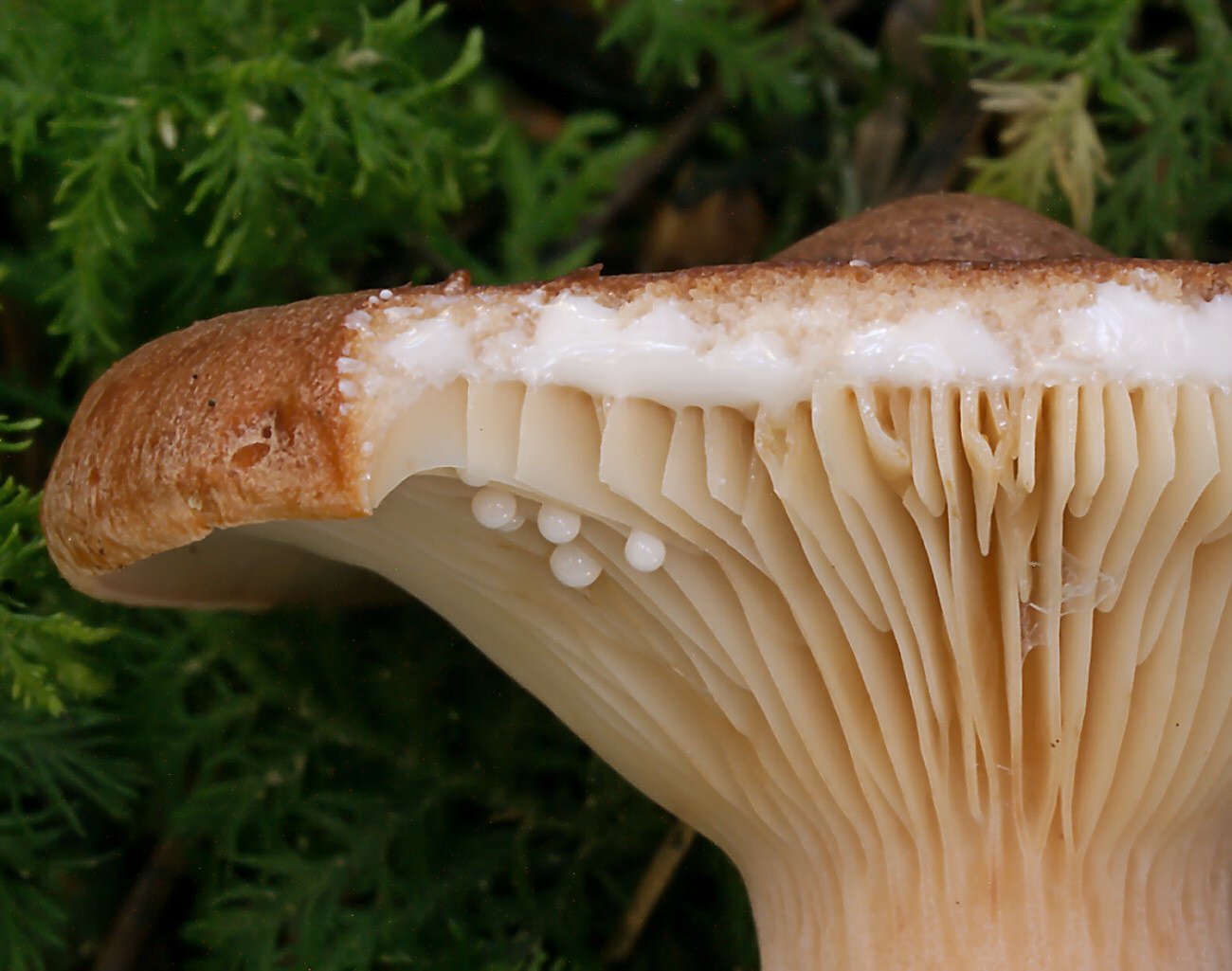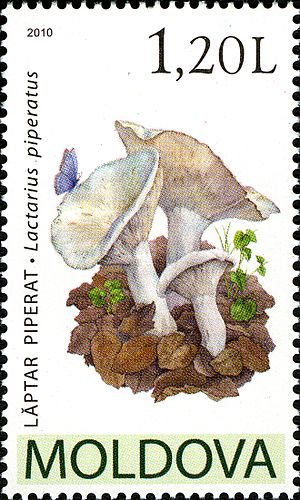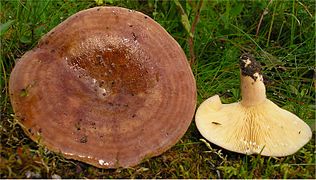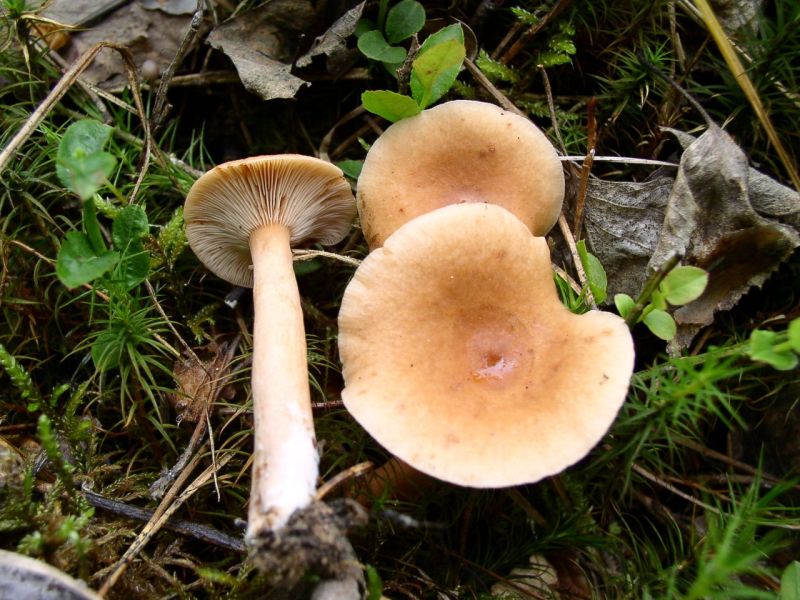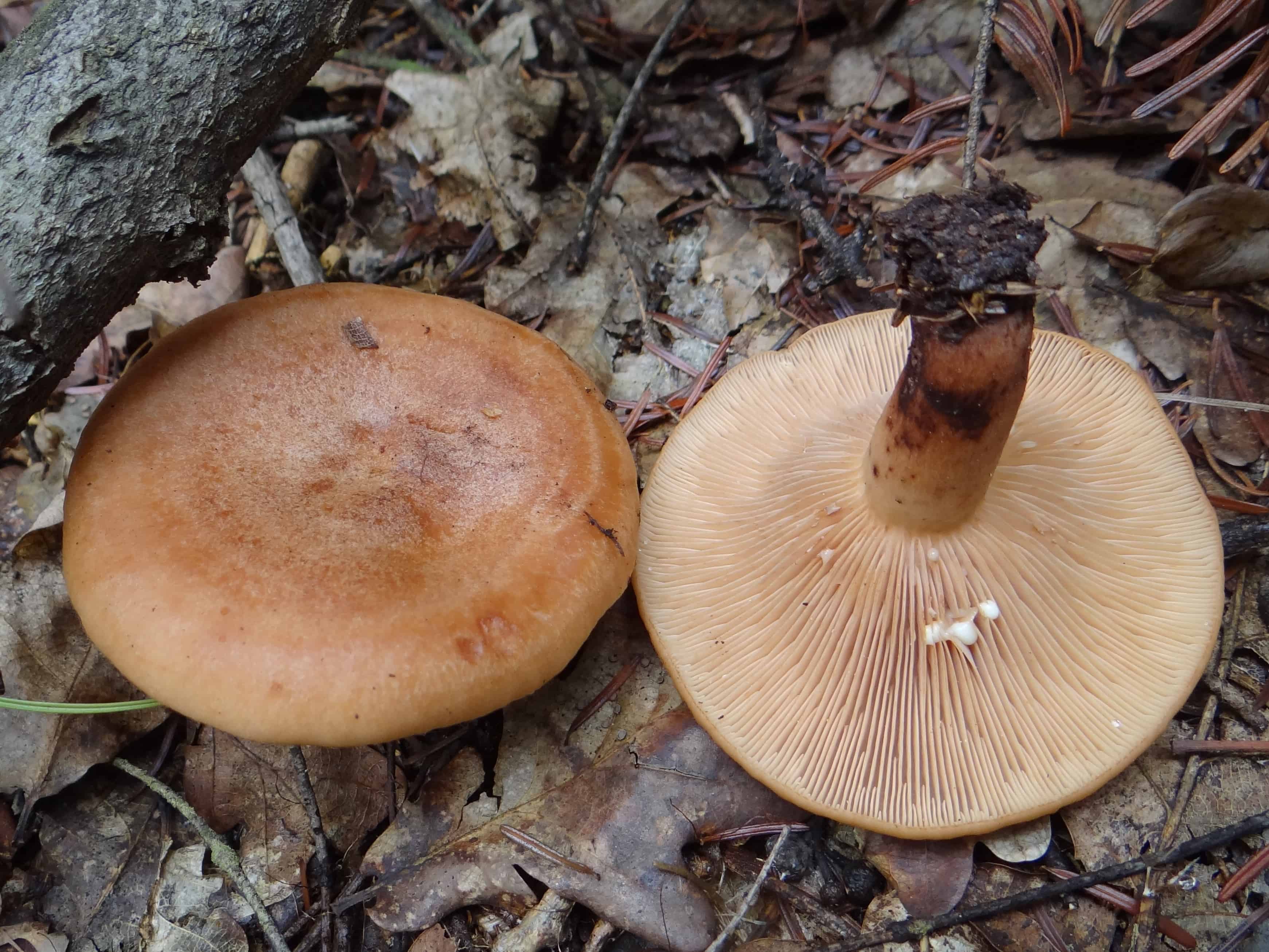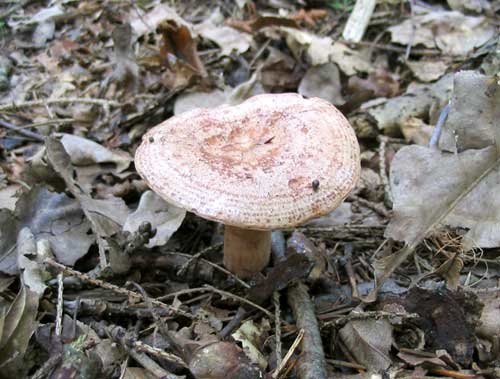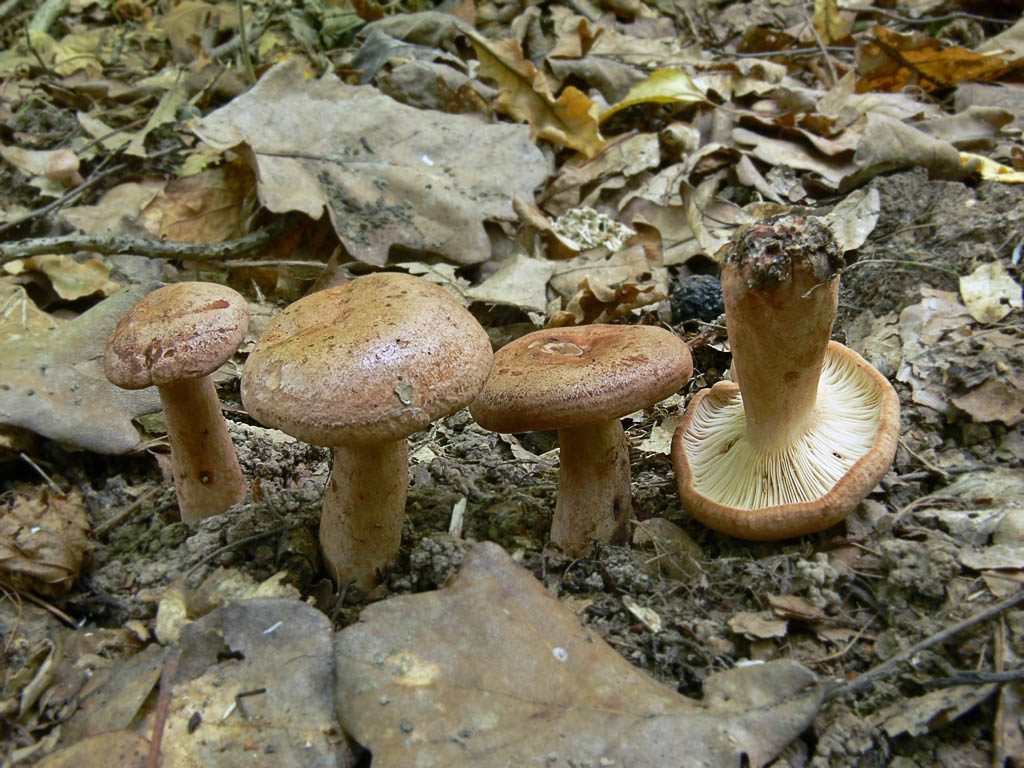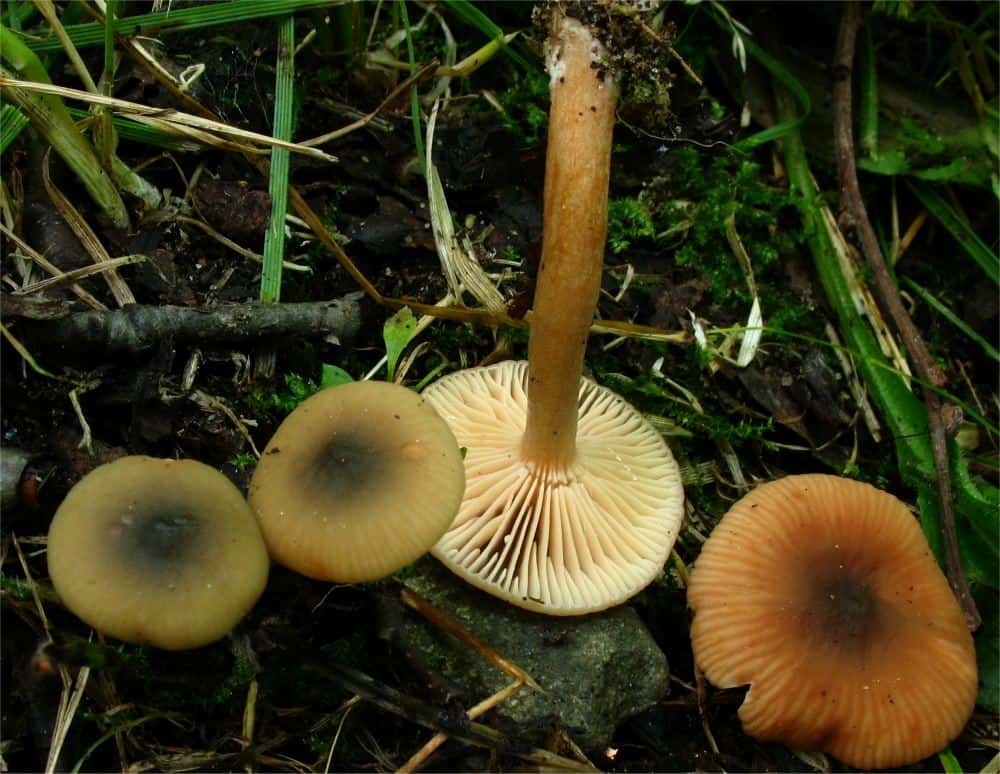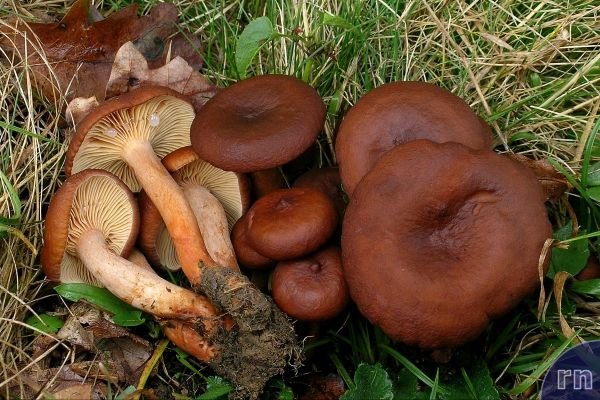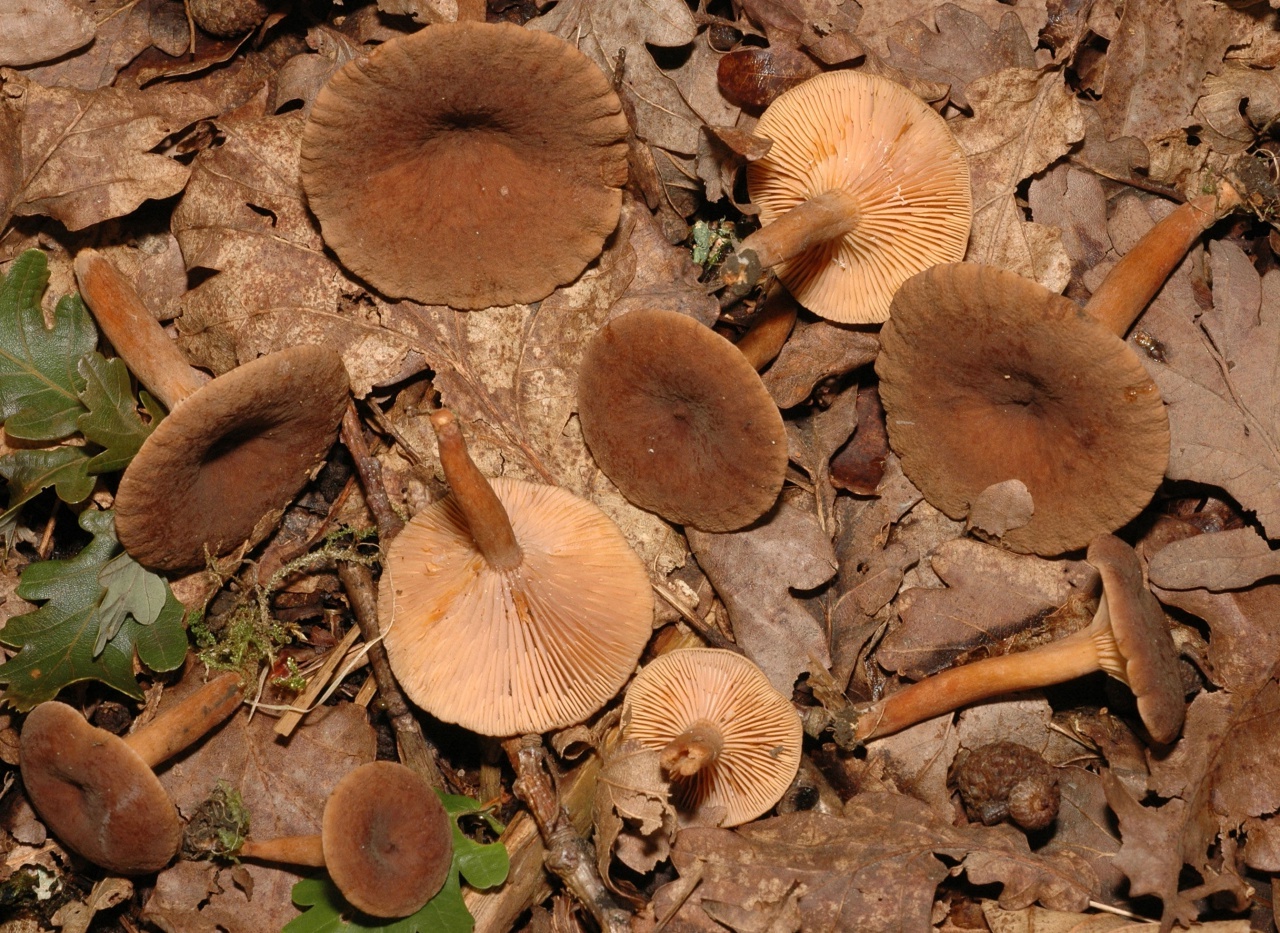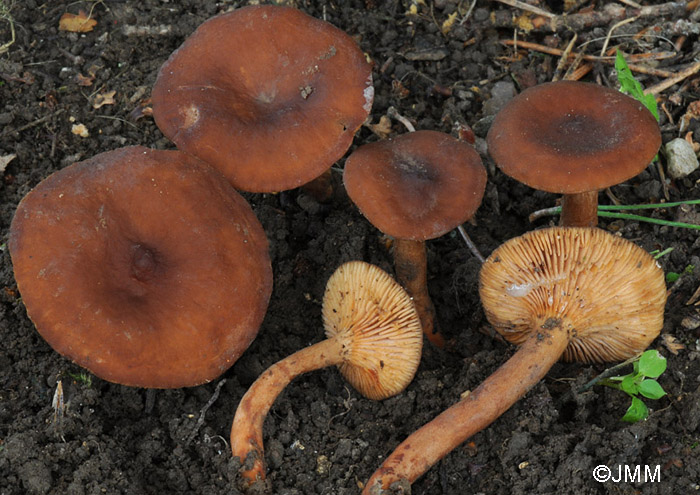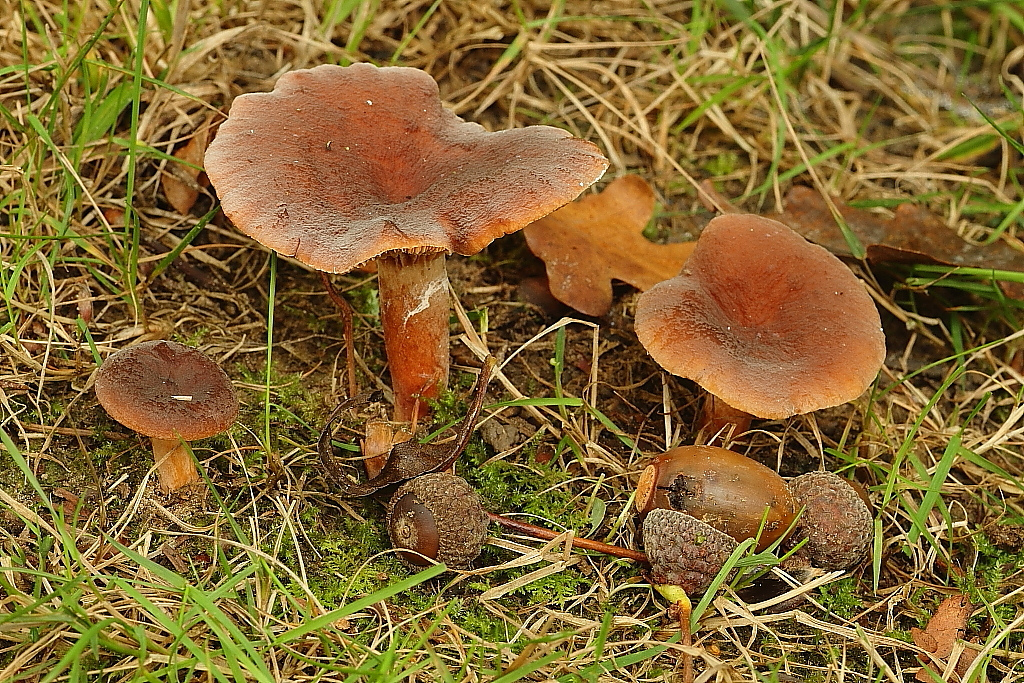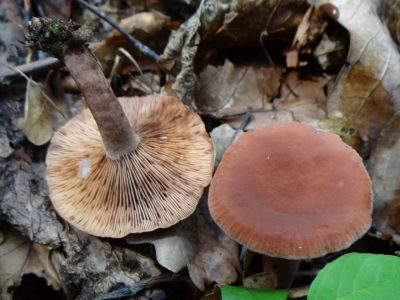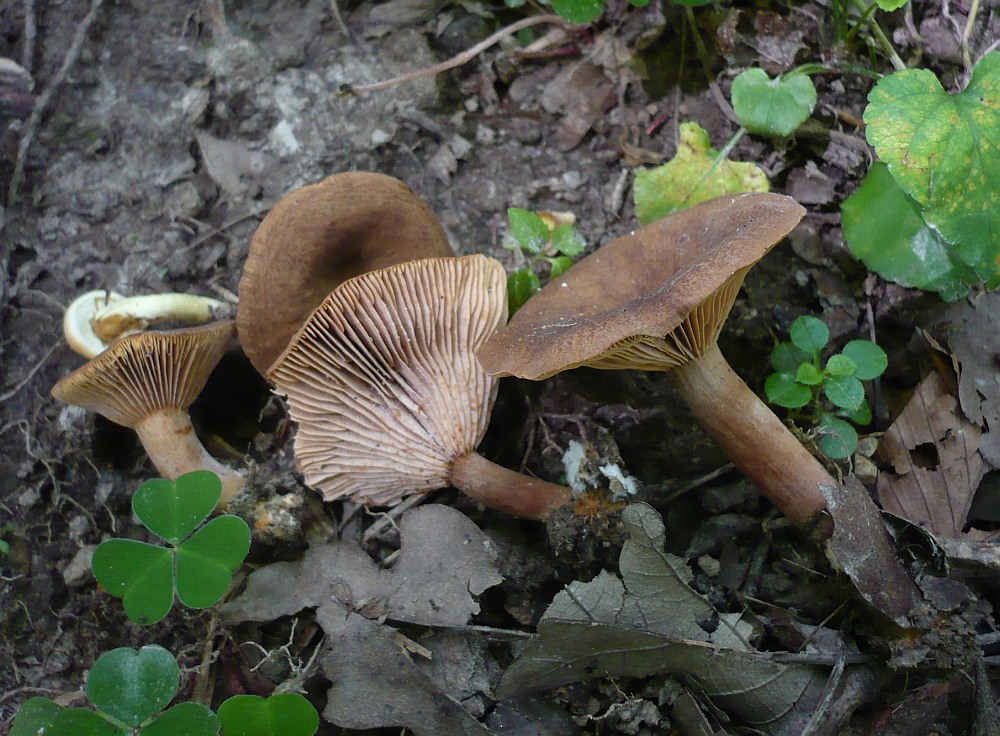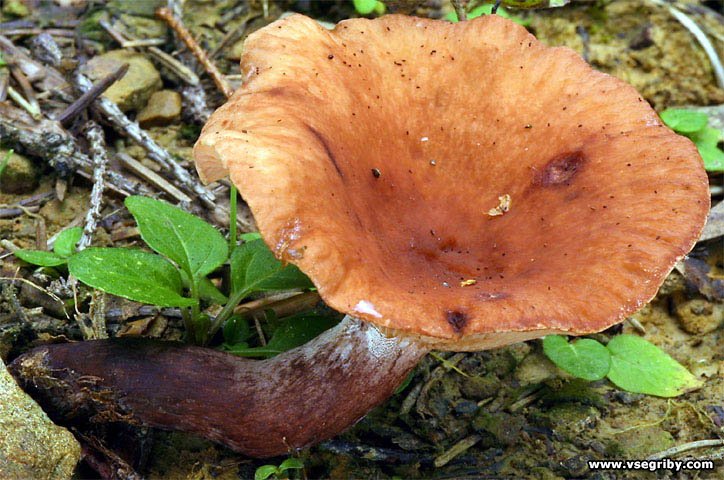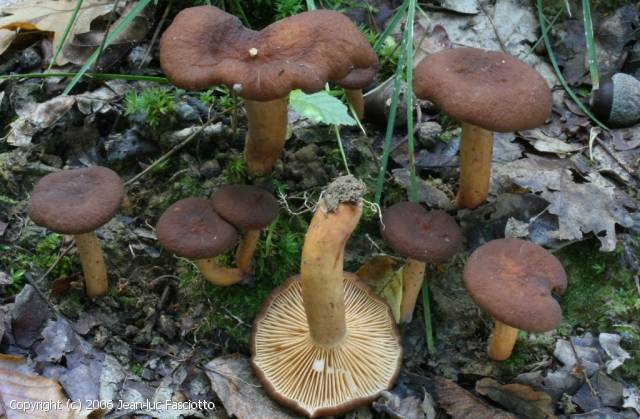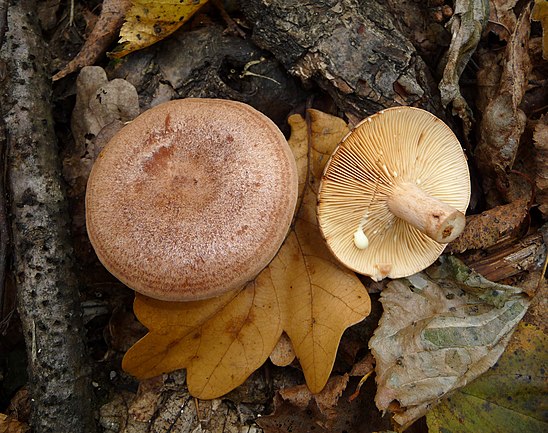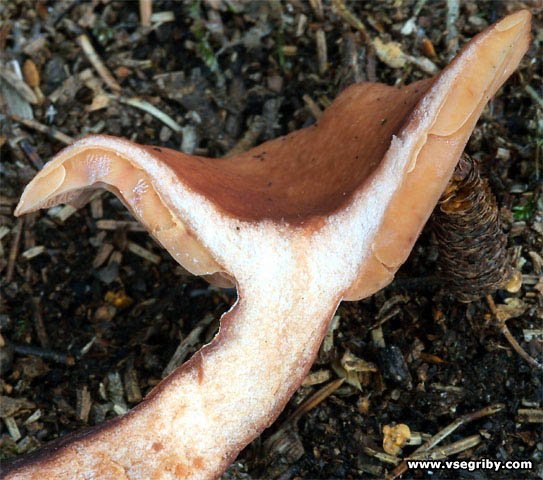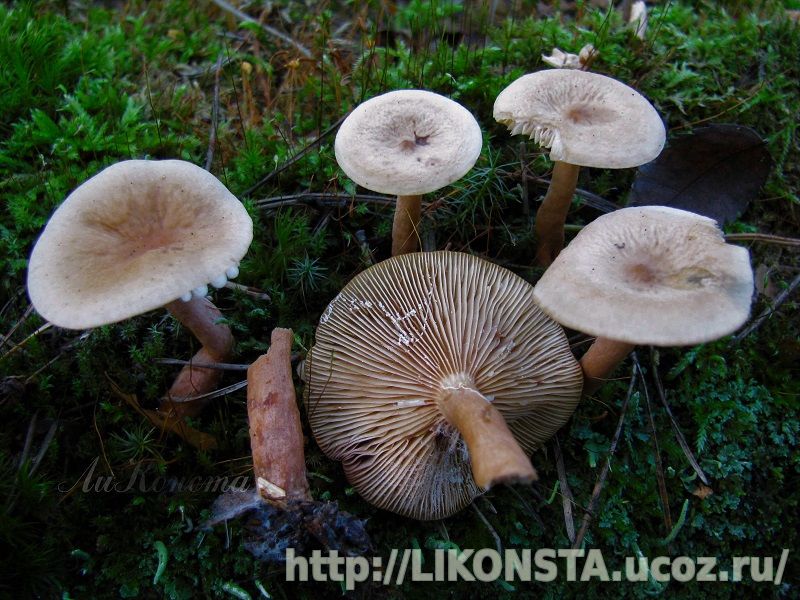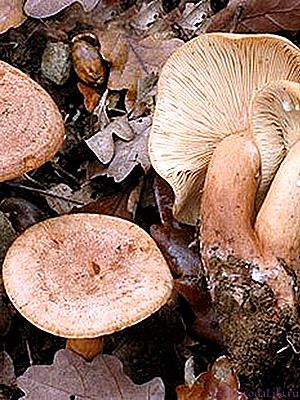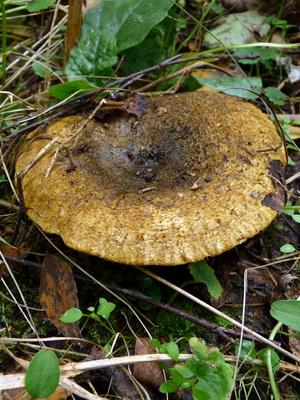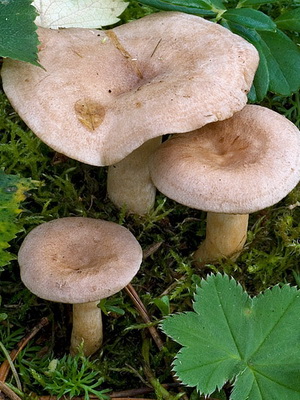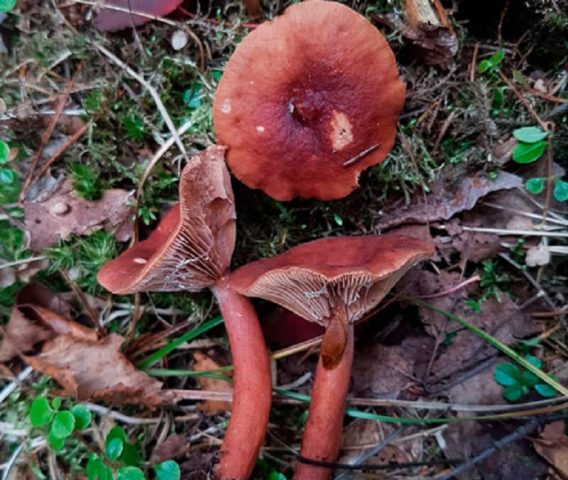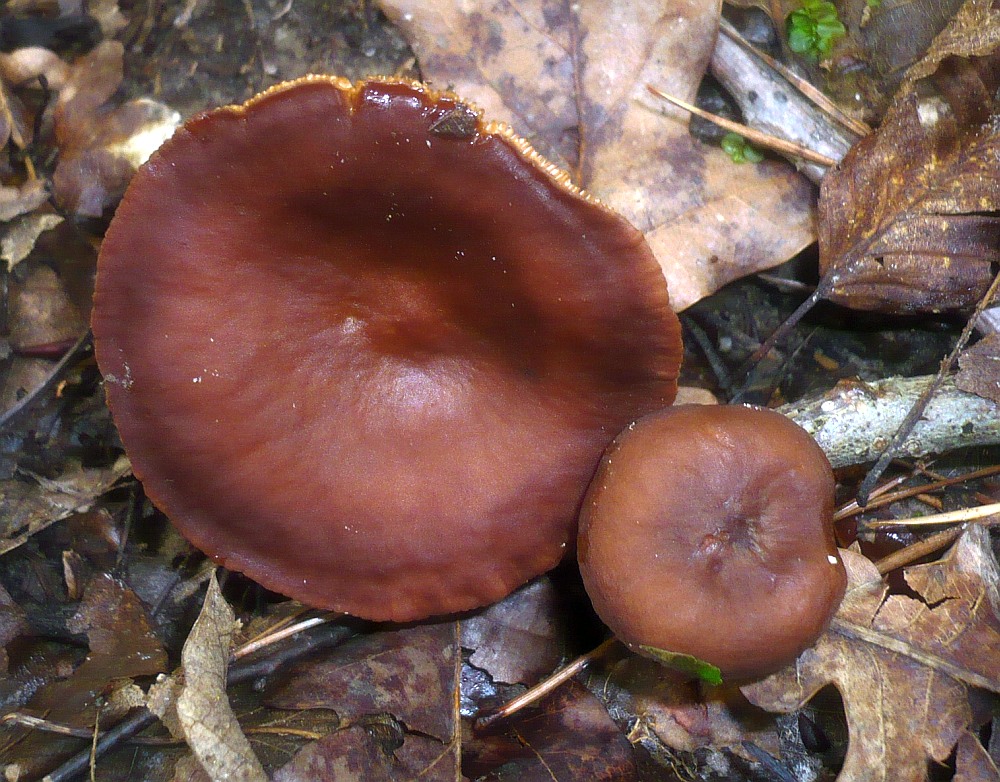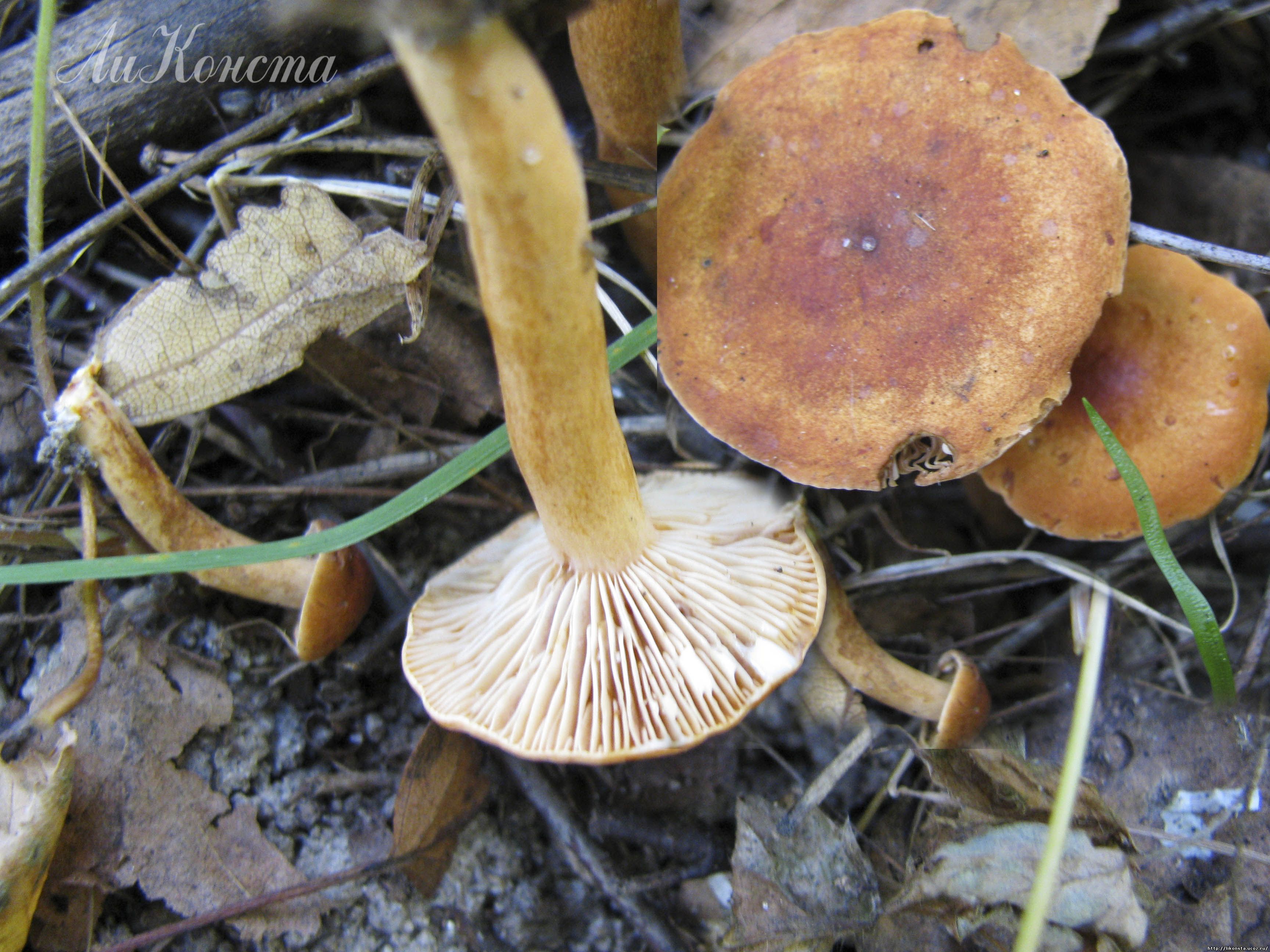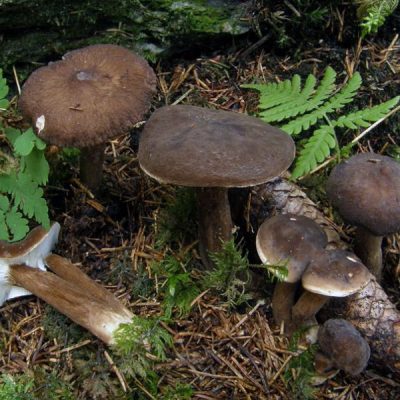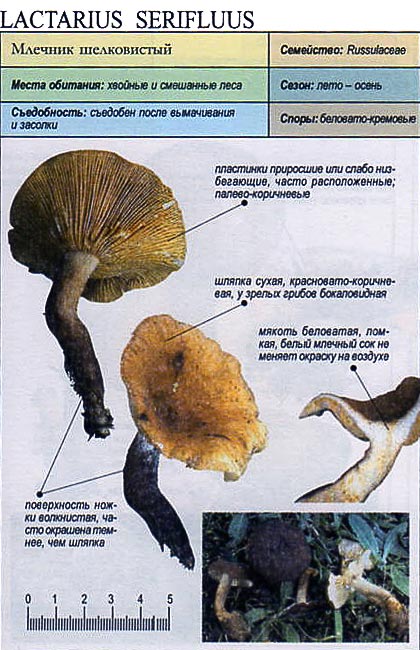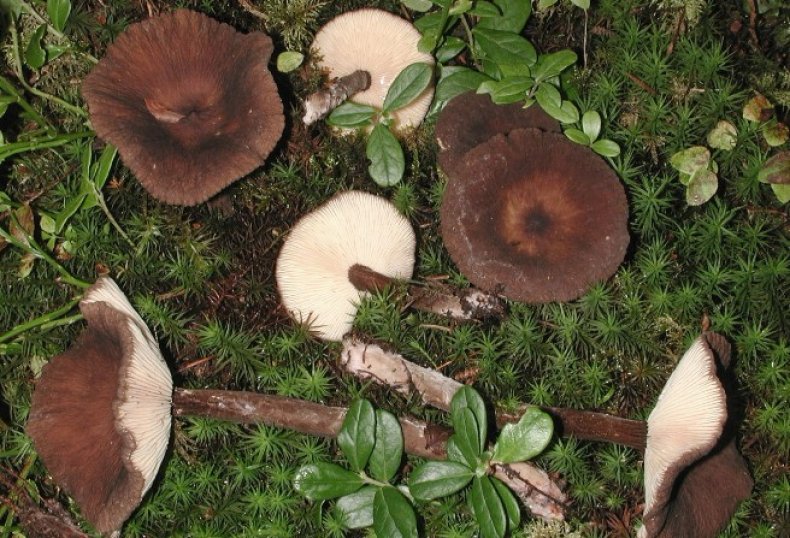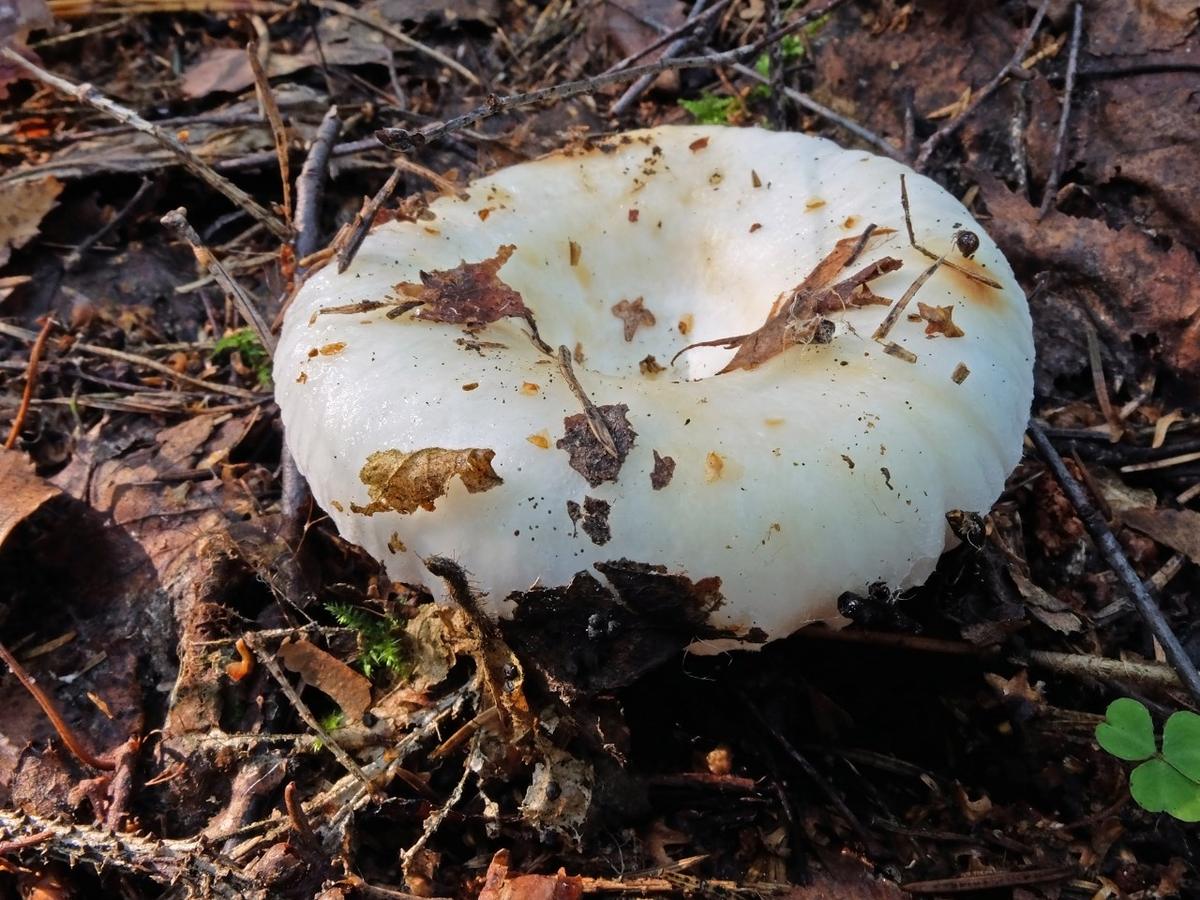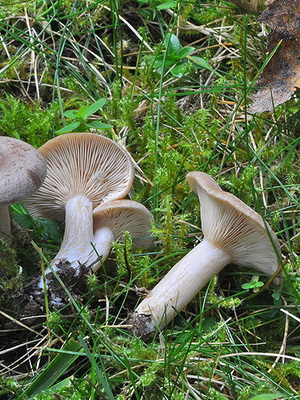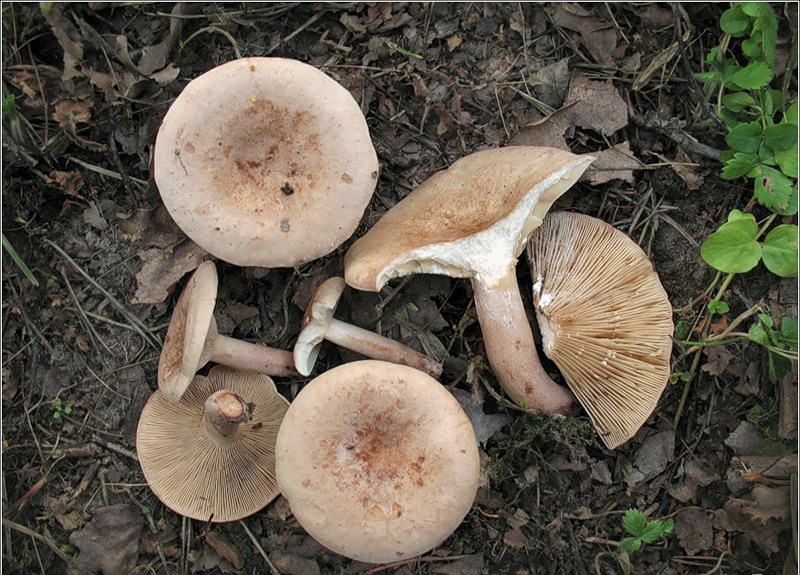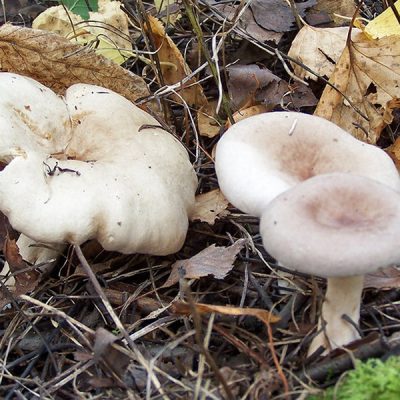Red-brown Milk (Lactarius volemus)
Synonyms:
- Galorrheus volemus
- Lactifluus volemus
- Amanita lactiflua
- Lactarius lactifluus
- Lactifluus oedematopus
- Lactarius oedematopus
- Lactarius ichoratus
- Galorrheus ichoratus
- Lactifluus ichoratus
- Lactarius testaceus
- Millechnik is the best (by the way, the official Russian-language mycological name)
- Podoreshnik (Belarusian - Padareshnik)
Lactarius volemus (Fr.) Fr., Epicr. syst. mycol. (Upsaliae): 344 (1838)
Description
A hat with a diameter of 5-17 (up to 16) cm, convex in youth, then prostrate, possibly pressed in the center, and even up to concave. The edge of the cap is straight, thin, sharp, first tucked up, then straightened and even raised. The color is reddish-brown, brownish-brown, in rare cases, rusty or light buffy. The surface is velvety at first, then smooth and dry. Often cracked, especially in dry conditions. There is no zonal coloration.
Flesh: White, yellowish, very fleshy and firm. The smell is described in various ways, mainly as a herring (trimethylamine) smell that increases with age, but there are more interesting associations, for example with pear flowers, or not at all. The taste is soft, pleasant, sweetish.
The plates are frequent, from adherent to weakly descending, creamy or warm skin shades, often forked at the leg. There are shortened plates (plates).
Milky sap is abundant, white, turning brown and thickening in the air. For this reason, this type of lactarius turns brown and everything else if damaged - pulp, plates.
The leg is 5-8 (up to 10) cm high, (1) 1.5-3 cm in diameter, hard, often full, the color of the cap, but slightly paler, smooth, may be covered with fine pubescence, which looks like frostiness, but not to the touch felt. Often tapered to the bottom.
The spore powder is white. The spores are close to spherical, according to the data 8.5-9 x 8 µm, 9-11 x 8.5-10.5 µm each. The ornamentation is ridged, up to 0.5 µm in height, forming an almost complete network.
Habitat
Occurs from July to October. One of the earliest milkmen. Grows in deciduous, mixed and spruce forests (in general, in all forests). According to the data, it forms mycorrhiza with oak (Quercus L.), common hazel (Corylus avellana L.) and spruce (Picea A. Dietr.).
Similar species
Given the "power" of this mushroom and the abundant brownish sweetish milky juice, perhaps, it has no similar species. The most similar lactic to him, perhaps, is the hygrophoroid lactarius - Lactarius hygrophoroides, but it is easily distinguished by non-brown milky juice and rare plates. Quite conditionally, rubella (Lactarius subdulcis) can be attributed to similar species, but it is thin-fleshed and slender. The same applies to the orange lactarius (Lactarius aurantiacus = L. mitissimus), it is not only small and thin, but also late, does not overlap in terms, although it grows in exactly the same biotopes with spruce.
Edibility
An edible mushroom that can be eaten raw. It is good in raw salted or pickled form, without any heat treatment. I don't like it in another form because of the "wooden" pulp, although, they say, mushroom caviar is good from it. I hunt him specifically and purposefully, for the sake of raw salting.
Literature Used 1) Verbeken, A. & Vesterholt, J. 2008. Lactarius. - In: Knudsen, H. & Vesterholt, J. (eds.): Funga Nordica, 82-107.2) Flora of Belarus. Mushrooms. In 7 volumes. Volume 1. O.S. Gapienko, Ya.A. Shaporova, 2012, Boletales. Amanitales. Russulales.
Video about the miller mushroom:
Other milkmen
The wet miller has a cap with a diameter of 4-8 centimeters. In youth, the shape of the caps is convex, over time it changes to prostrate, then it becomes depressed, with a wide flat tubercle in the central part. The edge of the cap is bent, with a small pile. The color of the cap is steel-gray with a purple tint. The hat is smooth, sticky, and damp. The flesh of this mushroom is spongy, tender, its color is white, slightly yellowish, it quickly turns purple on the cut.
The pulp secretes abundant milky juice. The pulp has a pungent taste, and there is no particular smell. The leg height is 4-7 centimeters, and the thickness is 1-2 centimeters. The shape of the leg is cylindrical, towards the base it becomes narrower. The leg is strong in structure, its surface is sticky.
Wet milkers bear fruit from August to September. They are rare enough. They grow in small groups or individually. These are inedible or slightly poisonous mushrooms. They can be found in mixed and deciduous forests, in humid places, not far from birches.
The sharpest miller is characterized by a cap, the diameter of which is 2-10 centimeters, concave with a slightly wavy edge. The hat is naked, smooth, it becomes wet in damp weather.

The color combines different shades of ocher, while the center of the cap is darker. The length of the leg reaches 10 centimeters, with a thickness of 1.5 centimeters. The leg is hollow, cylindrical, with a smooth surface, slightly lighter than the cap. The pulp is dense, white, with a sharp taste, without any special smell. Milky juice is white. The sharpest milkmen grow in the deciduous forests of Europe. They can be found under the oak trees. These are inedible mushrooms.
The color combines different shades of ocher, while the center of the cap is darker. The length of the leg reaches 10 centimeters, with a thickness of 1.5 centimeters. The leg is hollow, cylindrical, with a smooth surface, slightly lighter than the cap. The pulp is dense, white, with a sharp taste, without any special smell. Milky juice is white. The sharpest milkmen grow in the deciduous forests of Europe. They can be found under the oak trees. These are inedible mushrooms.
The miller is pale, or dull, or pale yellow has a cap up to 12 centimeters in diameter. The shape is convex in young milkers, and in mature ones it becomes funnel-shaped-depressed. The surface of the cap is smooth, slimy. The color of the cap is light ocher. The leg length ranges from 7 to 9 centimeters and the thickness is 1.5 centimeters. The color of the leg is the same as the cap. The leg is cylindrical, empty inside. The pulp is creamy or white, rather thick with a pleasant aroma and pungent taste.
Pale milkmen bear fruit from July to August. These fungi form mycorrhiza with oaks and birches. They are rare, mainly in deciduous, mixed forests and oak forests. Fruiting bodies grow in small groups. Pale millers are conditionally edible mushrooms. Most often they are salted with other delicious mushrooms.

Millers and lilac and umber
The lilac miller is a rather rare conditionally edible lamellar mushroom that grows singly or in small groups during one month - September. It is easiest to find it on moist soil in coniferous and deciduous forests, especially in the vicinity of oak or alder.
In young mushrooms, the cap is flat-convex; in mature mushrooms, it becomes funnel-shaped, with thin drooping edges. Its diameter is about 8 cm. The surface of the cap is dry, matte, finely pubescent, dirty pink or lilac in color. The plates are narrow, adherent, painted in a lilac-yellow color. The leg is rounded, may be slightly flattened, hollow inside, about 8 cm high and about 1 cm in diameter. Its surface is smooth and dry. The pulp is thin, brittle, tender, white or pinkish, tasteless and odorless. Milky sap is bitter and retains its original white color upon contact with air.
It is best to salt the lilac miller, but first it should be soaked for several days in cold water or boiled (drain the water!).
Umber miller is a rare conditionally edible lamellar mushroom that grows singly or in small groups during the first month of autumn. Places of growth are deciduous and coniferous forests.
The cap of the mushroom is convex, with curved edges, but over time it becomes like a funnel with cracked or lobed-tuberous edges. Its diameter is about 7–8 cm. The surface of the cap is smooth, dull, dry, brownish or reddish brown.
Spore-bearing plates are forked, adherent, first yellow and then yellow. The leg is rounded, thinner at the base, solid inside, about 5 cm high and about 1–1.5 cm in diameter. Its surface is smooth, dry, grayish in color.The pulp is thin, brittle, elastic, turns brown in the air, practically odorless and tasteless. The milky juice secreted by the pulp retains its white color when exposed to air.
Umber miller belongs to the third category of mushrooms. Like most milkmen, it is primarily suitable for salting, but first it must be boiled for at least 15 minutes.
Places of growth of watery-milky milky.
Watery-milky lactic acid-lacquers settle singly or in small groups. Their habitats are mixed and deciduous forests. Silky milkers bear fruit actively from August to September.

The yield of silky milkers depends entirely on the weather in the summer. If it was warm and humid in the summer, then the yield of watery-milky lactic acid makers will be large. The weather is especially important in mid-September.
Evaluation of the edibility of watery-milky lactarius.
This mushroom is conditionally edible. Only salted milkmen are eaten. Many mushroom pickers do not like watery-milky lactaciers and do not collect them, since they have a low nutritional value. Their taste also cannot be called excellent. Silky milky differs from other representatives of the family by a weak fruity aroma.

Before salting, the watery milky milk must be soaked in cool salty water, this procedure will help remove the unpleasant bitter juice. Then these mushrooms are often boiled well.
Related species.
The resinous black miller is also conditionally edible. His hat is matte, brown, chocolate brown or black-brown. The shape of the cap is initially convex, then becomes slightly concave. The leg is cylindrical, hollow inside, but at the same time rigid. The color will match the hat. The pulp is white or yellowish, may turn pink at the fracture, dense in structure. A pale milky juice is released from it, which turns red in air. The juice has a bitter taste.

Fruiting of resinous black milkmen occurs from August to September. The habitats are coniferous and mixed forests. They grow in groups. They are not often found in nature.
The stunted miller is another conditionally edible representative of the family. His hat can be convex or open. The leg inside is at first loose, and then becomes completely empty, its color is the same as that of the cap. The pulp has a slight pungent flavor. The milky juice is not very abundant, at first it is yellow, and when it dries, it is white.

The stunted milky settles in damp and humid places. You can find these mushrooms on mossy surfaces. They grow in mixed and deciduous forests. Stunted milkmen bear fruit from July to September.
Significance in human life [| ]
According to M.V. Vishnevsky, all species of the genus are edible.
In Europe, the overwhelming number of species of the genus Lactarius
considered inedible, or even poisonous. In Russia, many species are considered edible, usually in salted or pickled form.
Some lactosers are used in medicine. From this mushroom (Lactarius deliciosus
) and close to it red mushroom (Lactarius sanguifluus ) with red milky juice, the antibiotic lactarioviolin was isolated, which suppresses the development of many bacteria, including the causative agent of tuberculosis. Pepper milk (Lactarius piperatus ) is used in the treatment of kidney and gallstone diseases, blennorrhea, acute purulent conjunctivitis. Bitter (Lactarius rufus ) contains an antibiotic substance that adversely affects a number of bacteria, as well as inhibits the growth of cultures of Staphylococcus aureus [source not specified 1347 days ].
Pickled shiitake mushrooms, usually grown in China, are often sold under the name "pickled milk mushrooms" and are also edible.
In philately
As of 2020, there have been at least 114 different postage stamps issued around the world with images of the dairymen.
Lactarius piperatus on a Moldavian postage stamp (# 694) Lactarius piperatus on a Romanian postage stamp (# 4290)
- Lactarius blennius - Guinea (# 2523)
- Lactarius camphoratus - Guyana (# 3683), Mauritania (# 1059), Niger (# 1734)
- Lactarius chrysorrheus - Guinea-Bissau (# 3863)
- Lactarius claricolor - Madagascar (# 1632)
- Lactarius deceptivus - Mali (# 1484)
- Lactarius deliciosus - Algeria (# 1013), Angola (# 1421), Bulgaria (# 1267) (# 1275), Botswana (# 318), Guinea (# 762) (# 4255) (# 4681) (# 4741), Guinea -Bissau (# 849), Honduras (# 1845), Spain (# 3143), Cyprus (# 924), Lesotho (# 1317), Liberia (# 4025), Mali (# 1480), Mozambique (# 1058), Nicaragua (# 3003), Poland (# 1096), Romania (# 1724) (# 6263), Sao Tome and Principe (# 1631), Saint Vincent and the Grenadines (# 5204), Somalia (# 503), USSR (# 2987), Sierra Leone (# 1078) (# 3723) (# 5215), Togo (# 2355) (# 2818), Turkey (# 3034), Uganda (# 2930), Croatia (# 255), CAR (# 2876)
- Lactarius deterrimus - Afghanistan (# 1845), Norway (# 991), Finland (# 830)
- Lactarius dryadophilus - Greenland (# 465) (# 468)
- Lactarius fulvissimus - Guinea (# 2548) (# 2556)
- Lactarius gymnocarpus - Cote d'Ivoire (# 1194)
- Lactarius helvus - Guinea-Bissau (# 4302), Liberia (# 5240)
- Lactarius hepaticus - Guinea (# 5217)
- Lactarius hygrophoroides - Bhutan (# 2077), Grenadines (Grenada) (# 1447), DPRK (# 3001)
- Lactarius indigo - Guyana (# 6932), Guinea (# 1613), Liberia (# 4026), Mali (# 1485), El Salvador (# 2258), Sierra Leone (# 2573) (# 2579)
- Lactarius lignyotus - Mali (# 1487), Monaco (# 1864), Switzerland (# 2339)
- Lactarius luculentus - Mali (# 1481)
- Lactarius pandani - Madagascar (# 1314) (# 1541)
- Lactarius peckii - Mali (# 1486), Saint Vincent and the Grenadines (# 5210)
- Lactarius phlebonemus - DRC (# 602) (# 1072)
- Lactarius piperatus - Moldova (# 694), Romania (# 4290)
- Lactarius porninsis - Guinea (# 2529)
- Lactarius pseudomucidus - Mali (# 1482)
- Lactarius putidus - Grenadines (Grenada) (# 774)
- Lactarius resimus - Mongolia (# 1138)
- Lactarius rufus - Nevis (# 1146), Saint Vincent and the Grenadines (# 5211)
- Lactarius romagnesii - Bhutan (# 2078)
- Lactarius salmonicolor - Tanzania (# 3793)
- Lactarius sanguifluus - Andorra (Spanish) (# 167), Guinea (# 2525), Spain (# 3104)
- Lactarius semisanguifluus - CAR (# 4377)
- Lactarius scrobiculatus - Zambia (# 846), Cambodia (# 2064), Mali (# 1483), Mongolia (# 350)
- Lactarius torminosus - Belarus (# 973), Bhutan (# 1152), Guinea-Bissau (# 3861), Comoros (# 1485), Mongolia (# 346), Sao Tome and Principe (# 3005), Finland (# 864)
- Lactarius trivialis - Montserrat (# 1205), The Grenadines (Grenada) (# 2619)
- Lactarius turpis - Antigua and Barbuda (# 3427), Nevis (# 1142), Sao Tome and Principe (# 3006)
- Lactarius uvidus - Grenada (# 3587)
- Lactarius vellereus - Niger (# 1501)
- Lactarius volemus - Guinea Bissau (# 5651), Grenada (# 3595), Dominica (# 1403), DPRK (# 4221), Sao Tome and Principe (# 1638) (# 2009)
Description of the gray-pink milky
The hat of the gray-pink lactarius is large - its diameter is 8-15 centimeters. The shape of the cap is more or less rounded. In the central part there may be a tubercle or, on the contrary, a depression. With age, both signs can appear at the same time. In young mushrooms, the edges are neatly tucked up, and gradually open with age. The color of the cap is difficult to describe, there are dull grayish, brown, pinkish tones. The surface is velvety and dry. The hat is not prone to hygrophilousness.
The pulp is brittle, thick, whitish in color, with a strong pleasant odor and a burning taste. Milky juice is watery, it stands out poorly. Adult mushrooms may not have milky juice at all. The plates are of medium frequency, slightly descending on the stem, of the same color with the cap or slightly lighter. Yellowish spore powder.
The leg is rather short and thick, its height is 5-8 centimeters, with a width of 1-2 centimeters. But when gray-pink milky grows in mosses, their legs can be much longer. The surface of the leg is smooth, gray-pink in color. The leg is strong in structure.
The spread of inedible milk mushrooms
These mushrooms grow in swamps. They can be found in mosses, birches and pines. Inedible milk mushrooms bear fruit from August to September. Under favorable conditions, they can grow in great numbers.
Edible gray-pink lactarius
The gray-pink miller is a conditionally edible mushroom. And in foreign literature they are referred to as weakly poisonous mushrooms. In our country, these mushrooms are sometimes considered inedible. These are low-value mushrooms, they are harvested when there are no commercial types of mushrooms. They have a strong specific smell, which is why they make an unpleasant impression on mushroom pickers.
Related species of inedible weight
The zoneless milky is widespread in Eurasia. These mushrooms are found in deciduous forests. Form mycorrhiza with oak trees. They live singly or in small groups. Fruiting from July to September. In lean years, they may not bear fruit at all.
The cap of the zoneless milk-keeper is flat, with a tubercle in the middle, its edges are even. The diameter of the cap is 9-11 centimeters. Its surface is velvety, sandy, brown, pale brown or dark brown. The leg is hollow, in shape it resembles a cylinder. The leg and the cap are monochromatic. The leg height is 7-9 centimeters. In young specimens, the legs are dense, and with age they become hollow.
The zoneless milky is an edible species.Suitable for pickling and salting. It is recommended to collect only young milkmen.
The zonal milky or oak mushroom is widespread almost everywhere, giving preference to broad-leaved forests with beech, oak and birch. Fruiting singly or in small groups. They are found from July to September. These mushrooms are conditionally edible and must be soaked before cooking to remove the bitterness.
The diameter of the zonal lactarius cap reaches 10 centimeters. The cap is very fleshy, at first funnel-shaped, then it becomes flat with raised edges. The surface of the cap is dry and becomes sticky in the rain.
The color of the cap is cream or ocher. The stem is central, very dense, cylindrical, hollow inside. Its color ranges from white to buffy. There may be a red patina on the stem.
Milky brown and watery milky
The brown milky, or woody milky, is a rather rare edible lamellar mushroom that grows singly and in small groups from mid-August to late September, giving the largest yields at the end of the season. It is found in coniferous forests, especially in spruce forests, at the foot of trees, as well as in dense and tall grass.
The cap of the mushroom is convex, with a blunt tubercle in the middle, but gradually it takes the shape of a funnel about 8 cm in diameter with lowered chopped edges. Its surface is dry, velvety, wrinkled, painted dark brown, sometimes even black, with a whitish coating in some cases. The plates are rare, adherent, first white and then yellow.
The leg is rounded, thinner at the base, solid inside, about 8 cm high with a diameter of only about 1 cm. The surface of the leg is dry, velvety, longitudinally furrowed, the same color as the cap, slightly lighter at the base. The pulp is thin, firm, firm, almost odorless, but with a bitter taste. Milky sap, which it secretes in large quantities, upon contact with air changes its initially white color to yellow, gradually turning into reddish or reddish.
The brown milky belongs to the second category of mushrooms. Only caps are eaten, since their flesh is softer. All kinds of dishes can be prepared from them. In addition, mushrooms are used for pickling.
Milky milky is a rare conditionally edible lamellar mushroom that grows singly or in small groups from early August to late September in deciduous, deciduous and mixed forests. The yield of the mushroom depends on weather conditions, therefore, it does not differ in consistently abundant fruiting.
Initially, the cap of the lactarius is flat-convex, but in the process of growth it becomes like a funnel with lobed-sinuous edges about 6 cm in diameter.The surface of the cap is smooth, dry, matte, reddish-brown in color, lighter at the edges. Spore-bearing plates are narrow, adherent, yellow colored. The leg is round, straight, less often curved, about 6 cm high and about 1 cm in diameter.
The surface is smooth, dry, dull, yellowish-brown in young mushrooms, reddish-brown in mature ones. The pulp is thin, watery, soft, light brown in color, with an original fruity aroma. Milky sap is colorless, has a sharp, but not pungent taste.
Milky milky belongs to the third category of mushrooms. It is eaten after preliminary soaking or boiling, most often in the form of pickles.
Further you can familiarize yourself with photos and descriptions of other types of lactarius mushrooms.
Taste qualities of faded milkmen
Mushroom connoisseurs give preference to faded milk-keepers for their excellent taste. But to achieve good taste is possible only with proper processing of mushrooms.
In raw white milkers, the flesh is current, brittle, gray in color, practically odorless, and the taste is bitter. You can get rid of bitterness through special processing.It is best to boil the milkmen, then they can be pickled and salted.
It is believed that the most delicious pale milkmen are salty ones. Before serving, milkers are soaked in salt water to remove excess salt.
Related species
The common milky, like many other lactarius, belongs to conditionally edible mushrooms. The diameter of the cap of the common lactarius is 8-15 centimeters. In young mushrooms, the shape of the cap is irregular, the surface is slimy, the color of the cap is from violet-lilac to pale-brownish. In old milkers, the caps become pinkish-brownish or yellow-lilac.
The plates descend on the pedicle, yellow, often located. The leg length ranges from 5 to 10 centimeters. The shape of the leg is cylindrical, even. With age, the leg becomes hollow. The color of the leg matches the cap.
The pulp is strong, white, spicy with a burning milky juice. The juice turns olive brown when dried. Elliptical spores. Spore powder, cream color.
The papillary milky is a conditionally edible mushroom. The diameter of the cap of the papillary lactic acid is 3-9 centimeters. The shape of the cap is concave or flat, there is a tubercle in the center, the edges are bent. The color of the cap is grayish brown, the surface is dry.
The length of the leg is 3-7 centimeters, the diameter is 1-2 centimeters. The shape of the leg is cylindrical. The surface of the leg is smooth, the same color as the cap. The plates are narrow, whitish in color, slightly descending along the pedicle.
The flesh is brittle, white in color with a slight coconut odor. Ornamented spores. Spore powder of grayish or whitish color. Milky sap is not abundant, white, it becomes dark in air.
Millens papillary grow in deciduous, mixed and coniferous forests. They grow in groups in sandy soil. The papillary lactarius bear fruit from August to September.
Brownish milky
- The mushroom is classified as conditionally edible. The top reaches a maximum of 12 cm in diameter, but there are specimens of 5-10 cm on average. The hat is colored with a chocolate shade, it quickly breaks. The edges are bent, the top itself becomes depressed over time. Feels like velvet.
- The base can be up to 11 cm long. It is colored brown, beige or white. The format is cylindrical. The plates on the inside of the hat are closely spaced, colored with ocher or pink pigment.
- The soft part breaks quickly, it is very fragile and white. If you make a cut, then when weathered, the pulp will change and become pinkish in this area. Smells delicious berries, no bitterness. It is necessary to search for copies in Europe. They bear fruit from mid-summer to early autumn.
- This mushroom is considered conditionally edible, as it is eaten more often than other varieties. The specimens are salted and dried. However, such mushrooms are consumed in the vastness of our homeland, in European countries they are not eaten.
conclusions
The common miller, or smooth, is a mushroom that only true mushroom pickers or gourmets can appreciate. But if prepared correctly, using the preliminary primary processing of the product, he can make himself fall in love with an ordinary consumer. It turns out to be divine in a salted form, but for this it requires a long and laborious preparation process. These mushrooms bear fruit for a rather long time, then when other mushrooms are already leaving, therefore, in fact, they have no competitors. And due to their high yield, they often appear on the tables of hospitable hosts and even on store shelves.
Some of the representatives of the milky species have found widespread use in modern medicine. From their milky juice, valuable antibiotics are obtained, which help in the treatment of such unsafe diseases as tuberculosis and staphylococcus aureus. Also, their beneficial properties allow you to fight purulent eye infections and are effective in gallstone disease.
It is important to remember how to properly collect and store these mushrooms so as not to put yourself at risk of poisoning or cause an eating disorder. And also do not forget that in European countries this mushroom belongs to poisonous, and only thanks to careful primary processing, it is allowed to use it in our regions.
Mushrooms of the genus Mlechnik belong to the Syroezhkov family. Their edibility category is low (3-4), however, despite this, milkmen were traditionally revered in Russia. Collect them now, especially those varieties that are suitable for pickling and pickling. In the mycological classification, there are about 120 species of Lactarius, about 90 of them grow on the territory of Russia.
The first among the milk-keepers in June are the milky ones that are not caustic and pale yellow. All lactarius are edible mushrooms and can be distinguished by the presence of juice at cut sites or breakages. However, they become edible, just like milk mushrooms, after preliminary soaking in order to eliminate bitterness. They grow in groups.
The September milkmen occupy large areas in comparison with the August ones, getting closer and closer to swampy places, rivers and canals.
Millers and milk mushrooms in October strongly change color after the first frost. This change is so strong that it can be difficult to distinguish between them. Only those milkmen who have not changed their appearance and properties under the influence of frost can be used for food, soaked and salted.
You can find photos and descriptions of the most common types of milky mushrooms on this page.
Habitats of the non-caustic milky (Lactarius mitissimus):
mixed and coniferous forests. They form mycorrhiza with birch, less often with oak and spruce, grow in moss and on litter, singly and in groups.
Season:
July-October.
The hat has a diameter of 2-6 cm, thin, at first convex, later spread out, becomes depressed by old age. There is often a characteristic tubercle in the center of the cap. The central area is darker. A distinctive feature of the species is the bright color of the cap: apricot or orange. The hat is dry, velvety, without concentric zones. The edges of the cap are lighter.
As you can see in the photo, the leg of this milky mushroom is 3-8 cm high, 0.6-1.2 cm thick, cylindrical, dense, then hollow, of the same color with the cap, lighter in the upper part:
The flesh of the cap is yellowish or orange-yellowish, dense, brittle, with a neutral odor. Under the skin, the flesh is pale yellow or pale orange, without a special smell. Milky juice is white, watery, does not change color in air, not pungent, but slightly bitter.
Plates, adherent or descending, thin, medium frequency, slightly lighter than the cap, pale orange, sometimes with reddish spots, slightly descending to the pedicle. The spores are creamy ocher in color.
Variability.
The yellowish plates become bright buffy over time. The cap color ranges from apricot to yellowish orange.
Similarity with other species. The non-caustic milky is similar to brownish milky (Lactatius fuliginosus)
, in which the color of the cap and leg is lighter and a brownish-brownish color is preferable, and the leg is shorter.
Cooking methods:


